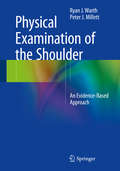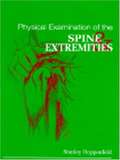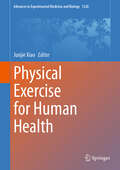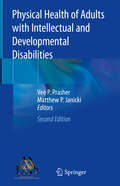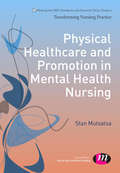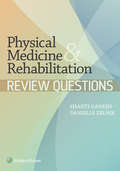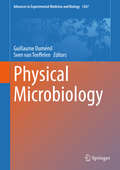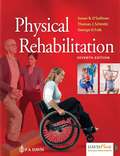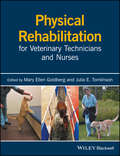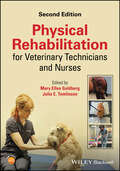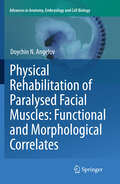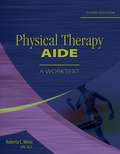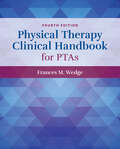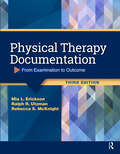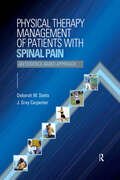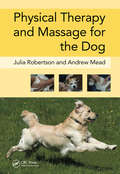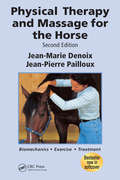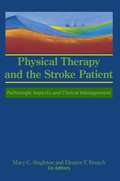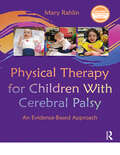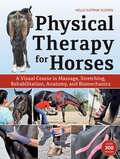- Table View
- List View
Physical Examination of the Shoulder
by Ryan J. Warth Peter J. MillettThis text presents a comprehensive and concise evidence-based and differential-based approach to physical examination of the shoulder in a manner that promotes its successful application in clinical practice. Additionally, this book provides an integrated approach to the diagnosis of numerous shoulder pathologies by combining discussions of pathoanatomy and the interpretation of physical examination techniques and was written for any health care professional or student who may be required to evaluate patients who present with shoulder pain. This information will allow the clinician to make informed decisions regarding further testing procedures, imaging and potential therapeutic options. Physical Examination of the Shoulder will serve as an invaluable resource for practicing orthopedic surgeons, sports medicine specialists, physical therapists, residents in training and medical students interested in the field of clinical orthopedics.
Physical Examination of the Spine and Extremities
by Stanley HoppenfeldUseful to students and clinicians, this text covers the process of physical examination of the spine and extremities.
Physical Exercise Interventions for Mental Health
by Michelle Riba Lam, Linda C. W. and Riba, Michelle Lam, Linda C. W.Exercise is well known to be beneficial to physical health; however, increasing research indicates that physical exercise is also beneficial to brain health and may alleviate symptoms of mental disorders. This book, written by international experts, describes and explores the theory and practice of exercise intervention for different mental disorders across the life span. Drawing on evidence from basic neuroscience research, and enriched with findings from the latest clinical trials, the work provides clear descriptions of current practice and highlights ways to translate this knowledge into pragmatic advice for use in daily practice. The chapters cover a broad range of conditions including neurodevelopmental disorders, depression, anxiety, psychosis and late life neurocognitive disorders. This book is for mental health clinicians including psychiatrists, psychologists, social workers, nurses, as well as internists, paediatricians and geriatricians seeking a comprehensive and individualized approach to treatment.
Physical Exercise and Natural and Synthetic Products in Health and Disease (Methods in Molecular Biology #2343)
by Paul C. GuestThis detailed book explores protocols with the aim of testing aerobic exercise, resistance training, special diets, additives and natural products, which have led to new insights into the physiological and molecular aspects of health and disease. Many of these approaches have contributed to significant improvements in disease areas such as cardiovascular disease, cognitive dysfunction, diabetes, frailty, gliobastoma, metabolic syndrome, obesity, oxidative stress, and various cancers. This collection also provides important information on disease mechanisms and novel drug targets as each protocol is presented in the context of specific chronic diseases or different therapeutic areas. Written for the highly successful Methods in Molecular Biology series, chapters include introductions to their respective topics, lists of the necessary materials, step-by-step, readily reproducible protocols, and tips on troubleshooting and avoiding known pitfalls. Authoritative and reflective of research from all around the globe, Physical Exercise and Natural and Synthetic Products in Health and Disease serves as an ideal guide for researchers in the areas of chronic disease, exercise, and nutrition, as well as to clinical scientists, physicians, and pharmacologists as it gives insights into possibilities for the development of novel therapeutics and the means of monitoring therapeutic response through the measurement of molecular and physiometric biomarkers.
Physical Exercise for Human Health (Advances in Experimental Medicine and Biology #1228)
by Junjie XiaoThis book shares the latest findings on exercise and its benefits in preventing and ameliorating numerous diseases that are of worldwide concern. Addressing the role of exercise training as an effective method for the prevention and treatment of various disease, the book is divided into eleven parts: 1) An Overview of the Beneficial Effects of Exercise on Health and Performance, 2) The Physiological Responses to Exercise, 3) Exercise and Metabolic Diseases, 4) Exercise and Cardiovascular Diseases, 5) Exercise and Musculoskeletal Diseases, 6) Exercise and Neurological and Psychiatric Diseases, 7) Exercise and the Respiration System, 8) Exercise and Immunity, 9) Exercise and HIV/AIDS, 10) Exercise and Neuropsychiatric Disorders, and 11) Future Prospects. Given its scope, the book will be particularly useful for researchers and students in the fields of physical therapy, physiology, medicine, genetics and cell biology, as well as researchers and physicians with a range of medical specialties.
Physical Health of Adults with Intellectual and Developmental Disabilities
by Vee P. Prasher Matthew P. JanickiThis fully revised and expanded second edition brings together findings from research and clinical practice, with comprehensive coverage of the important aspects of physical health in persons with intellectual disability. Professionals involved in the medical and social care and support of persons with intellectual disability should have a broad understanding of the essential range of issues, and therefore this book provides a truly multi-disciplinary perspective, complete with many tables, figures, and illustrations to underline the key points. The reader is updated on ongoing developments in the general population, which will become increasingly more relevant to adults with intellectual disability. This book also acknowledges that the impact on the person and on their carers always needs to be taken into account, with treatment programs established with a multi-faceted team approach in mind. This book is aimed at an international audience of physicians and other allied health personnel concerned about the health and welfare of adults with intellectual disability. It should also be of interest to researchers, administrators, and senior program personnel engaged in this field.
Physical Healthcare and Promotion in Mental Health Nursing (Transforming Nursing Practice Series)
by Stanley MutsatsaIt is essential for mental health nurses to understand the physical health needs of people with mental health disorders in order to provide holistic care. Yet these people often have their physical health needs unrecognised or poorly managed. This book is a practical and informative guide to the physical health care of people with mental health illnesses. It covers a range of health-promotion strategies, including exercise, diet and oral health, and assessment, intervention and skills for common physical disorders found in people with mental-health problems. It takes a recovery perspective and emphasises the importance of communication and collaborative care for adherence to healthy lifestyles.
Physical Healthcare and Promotion in Mental Health Nursing (Transforming Nursing Practice)
by Stanley MutsatsaIt is essential for mental health nurses to understand the physical health needs of people with mental health disorders in order to provide holistic care. Yet these people often have their physical health needs unrecognised or poorly managed. This book is a practical and informative guide to the physical health care of people with mental health illnesses. It covers a range of health-promotion strategies, including exercise, diet and oral health, and assessment, intervention and skills for common physical disorders found in people with mental-health problems. It takes a recovery perspective and emphasises the importance of communication and collaborative care for adherence to healthy lifestyles.
Physical Medicine & Rehabilitation Review Questions
by Shanti Ganesh Danielle ZelnikThis concise question-and-answer review for American Board of Physical Medicine & Rehabilitation (ABPMR) board review examinations boasts over 600 multiple-choice questions covering the general competencies, core knowledge, and the common topics critical for exam success and professional competency. You’ll also find advice on how to approach the exam as well as test-taking tips and tactics.
Physical Microbiology (Advances in Experimental Medicine and Biology #1267)
by Guillaume Duménil Sven Van TeeffelenThis book emerges from the idea that specific physics-inspired approaches are necessary to understand different stage of bacterial physiology and the infections they cause. Many aspects of bacterial life depend on processes typically described by physical laws: The rheology of biofilms is determined by complex cohesive forces. Physical laws of diffusion are essential to all processes of bacterial metabolism. The formation of the numerous bacterial biomacromolecules require complex self-organization processes and their function are powered by potent molecular motors. Host-pathogen interactions during infection frequently occur in environments determined by fluid mechanics. In this book, different chapters represent research at the interface between microbiology and physics. Topics range from intracellular organization to cell-cell interactions. A good part of the book is devoted to mechanical forces, which are involved in the function of elaborate bacterial nanomachines, chromosome segregation, and cell division. The effect of bacterial toxins provides an example of the alteration of cellular membrane properties by bacteria. Symmetrically, histones from mammalian cells alter bacterial membranes as a defense mechanism during infection.The editors of this book, Guillaume Duménil and Sven van Teeffelen, have selected researchers at the forefront of research in physical microbiology to provide the most recent view in this fast-moving field. The contents of this book are designed to be accessible for scientists with training in biology and for scientists with training in physics. The objective is to provide a fresh perspective on microbiology and infection by highlighting recent multidisciplinary research and favor rapid advances at this fruitful interface.
Physical Rehabilitation
by Susan B. O'Sullivan Thomas J. Schmitz George FulkRely on this comprehensive, curriculum-spanning text and reference now and throughout your career! You’ll find everything you need to know about the rehabilitation management of adult patients… from integrating basic surgical, medical, and therapeutic interventions to how to select the most appropriate evaluation procedures, develop rehabilitation goals, and implement a treatment plan. Online you’ll find narrated, full-color video clips of patients in treatment, including the initial examination, interventions, and outcomes for a variety of the conditions commonly seen in rehabilitation settings.
Physical Rehabilitation (5th Edition)
by Susan B. O'Sullivan Thomas J. SchmitzThe text is designed to provide a comprehensive approach to the rehabilitation management of adult patients and is intended to serve as a primary textbook for professional-level physical therapy students, and as an important resource for practicing therapists as well as for other rehabilitation professionals.
Physical Rehabilitation for Veterinary Technicians and Nurses
by Mary Ellen Goldberg Julia E. TomlinsonPhysical Rehabilitation for Veterinary Technicians and Nurses provides a comprehensive, illustrated guide to all practical aspects of veterinary physical rehabilitation for veterinary technicians and nurses. Provides a comprehensive introduction to physical rehabilitation for veterinary technicians and nurses Offers a thorough grounding in the knowledge and skills needed to become a valued member of a veterinary rehabilitation team Features contributions from leading practitioners from across the United States sharing their knowledge and expertise on all aspects of veterinary physical rehabilitation Presents practical tips, tricks and advice to meet common challenges faced by rehabilitation technicians Covers pain management, hands-on therapy, therapeutic exercises, patient motivation, troubleshooting, and more
Physical Rehabilitation for Veterinary Technicians and Nurses
by Mary Ellen Goldberg Julia E. TomlinsonPhysical Rehabilitation for Veterinary Technicians and Nurses A must-own guide for veterinary professionals specializing in physical rehab Physical rehabilitation is a vital aspect of veterinary medicine. A successful program of rehabilitation is one of the most important determinants of long-term patient outcomes after surgery or serious illness, and veterinary patients are no exception. Veterinary technicians and nurses specializing in physical rehabilitation therefore constitute a potentially critical component of any veterinary practice and/or care team. Physical Rehabilitation for Veterinary Technicians and Nurses provides a clear, accessible overview of this subject for prospective veterinary rehabilitation professionals. Brimming with insights stemming from both research and practical experience, and now updated to reflect a wave of new research since the first edition, this book promises to equip readers with the knowledge required to make themselves indispensable in veterinary practice. Readers of the second edition of Physical Rehabilitation for Veterinary Technicians and Nurses will also find: Practical tips and tricks connected to the role of a technician on a rehabilitation teamNew or updated coverage of subjects including canine fitness, shockwave protocols, underwater treadmill exercises, and many moreGuidance ideal for training programs and certifications from the most important institutes and technician schools Physical Rehabilitation for Veterinary Technicians and Nurses is ideal as an introduction for prospective technicians and nurses, as well as a reference handbook for practicing veterinary technicians and nurses.
Physical Rehabilitation of Paralysed Facial Muscles: Functional and Morphological Correlates
by Doychin N. AngelovUsing a combined morpho-functional approach the author recently found that polyinnervation of the neuro-muscular juction (NMJ) is the critical factor for recovery of function after transection and suture of the facial nerve. Since polyinnervation is activity-dependent and can be manipulated, he tried to design a clinically feasible therapy by electrical stimulation or by soft tissue massage. First, electrical stimulation was applied to the transected facial nerve or to paralysed facial muscles. Both procedures did not improve vibrissal motor performance (video-based motion analysis of whisking), failed to diminish polyinnervation and even reduced the number of innervated NMJ to one fifth of normal values. In contrast, gentle stroking of the paralysed vibrissal muscles by hand resulted in full recovery of whisking. Manual stimulation was also effective after hypoglossal-facial anastomosis and after interpositional nerve grafting. The author concludes that manual stimulation is a non-invasive procedure with immediate potential for clinical rehabilitation following facial nerve reconstruction.
Physical Therapy Aide: A Worktext
by Roberta C. WeissThis work-text provides a basic understanding of the theory and clinical skills necessary to function as an entry-level physical therapy aide in different rehabilitation settings. The therapeutic modality procedures that an aide would perform are presented in a step-by-step format with detailed photos. A variety of review questions test comprehension of the material. Learning activities are provided at the end of each chapter for practical application. Benefits: * NEW Over 150 new photographs illustrate various clinical skills and physical therapy modalities * NEW New chapters on the administrative role of the physical therapy aide and getting and keeping a job in physical therapy * NEW Examples of strong resumes and cover letters * NEW Multiculturalism in health care and the need for analytical, problem-solving, and decision-making skills in the workplace * Work-text format prepares learners to become entry-level physical therapy aides * Behavioral objectives and key terms enhance learning and review * Rationales for situational therapeutic treatments * Provides a background in anatomy and physiology as it relates to physical therapy * Full-color insert includes 21 individual illustrations of various structures and systems of the human body
Physical Therapy Clinical Handbook for PTAs
by Frances WedgePhysical Therapy Clinical Handbook for PTAs, Fourth Edition is a concise clinical guide designed specifically to help physical therapist assistant students and practitioners easily obtain helpful evidence-based information. This succinct handbook covers the evaluative as well as the interventional aspect of physical therapy and offers immediate guidance concerning physical therapy data collection and interventions, including musculoskeletal, neurologic, cardiopulmonary, integumentary, geriatric, pediatric, and acute care interventions. NEW: Chapter on pain management, which contains relevant discussions about the opioid crisis, alternative strategies for the physical therapist (PT), and outcomes related to the PT for pain managementNEW: Chapter addressing soft skills and communicationA robust photo and art program that includes coverage of manual muscle testing, range of motion, PNF, gait cycle, and developmental sequencesEasy-to-reference medication tables for interventions covered in the textIncorporates the American Physical Therapy Association's (APTA) Direction and Supervision Algorithms in an enhanced discussion of interprofessional collaborationA range of additional content in covering geriatric interventions, including general considerations for common geriatric-related conditions, an explanation of Medicare Parts C and D, and levels of supervision for the PTA with the Medicare patient © 2023 | 752 pages
Physical Therapy Documentation: From Examination to Outcome
by Mia Erickson Rebecca McKnight Ralph UtzmanNewly updated and revised, Physical Therapy Documentation: From Examination to Outcome, Third Edition provides physical therapy students, educators, and clinicians with essential information on documentation for contemporary physical therapy practice.Complete and accurate documentation is one of the most essential skills for physical therapists. In this text, authors Mia L. Erickson, Rebecca McKnight, and Ralph Utzman teach the knowledge and skills necessary for correct documentation of physical therapy services, provide guidance for readers in their ethical responsibility to quality record-keeping, and deliver the mechanics of note writing in a friendly, approachable tone. Featuring the most up-to-date information on proper documentation and using the International Classification of Functioning, Disabilities, and Health (ICF) model as a foundation for terminology, the Third Edition includes expanded examples across a variety of practice settings as well as new chapters on: Health informatics Electronic medical records Rules governing paper and electronic records Billing, coding, and outcomes measures Included with the text are online supplemental materials for faculty use in the classroom.An invaluable reference in keeping with basic documentation structure, Physical Therapy Documentation: From Examination to Outcome, Third Edition is a necessity for both new and seasoned physical therapy practitioners.
Physical Therapy Management of Patients with Spinal Pain: An Evidence-Based Approach
by Deborah Stetts Gray CarpenterIn this rapidly changing health care environment, a challenge today’s physical therapist faces is finding, evaluating, and implementing current best evidence into practicce, an integral part of health care professional educational programs. With that goal in mind, Physical Therapy Management of Patients With Spinal Pain: An Evidence-Based Approach provides a comprehensive research-based overview of the examination and physical therapy interventions of the spine. Inside Physical Therapy Management of Patients With Spinal Pain, Drs. Deborah M. Stetts and J. Gray Carpenter evaluate the current evidence related to spinal pain and present it in a format that allows for an easy transition to the clinical environment. By providing effective clinical interventions, rather than relying on habits or tradition, patients benefit from an increased likelihood of improved quality of life with the least potential of personal and financial risk.Some features include:• Over 650 photographs, images, and tables• Access to a supplemental video Website with new book purchase• Best practice for evaluating and treating the lumbar spine, thoracic spine, and cervical spine• Comprehensive coverage of the clinical presentation of spine-related pathologies from evaluation to treatmentEach chapter outlines the history, physical examination, physical therapy diagnosis, evidence-based management guidelines, and case studies for each topic. Case studies will challenge the reader’s clinical reasoning skills with the use of current best evidence throughout the initial examination and subsequent treatment sessions.Bonus!Also included with Physical Therapy Management of Patients With Spinal Pain is access to a supplemental Website containing more than 375 video demonstrations corresponding to the tests and measures, examination, evaluation, and intervention procedures covered within the text.Physical Therapy Management of Patients With Spinal Pain: An Evidence-Based Approach is the go-to reference text and accompanying Web site for the physical therapy students, or clinicians who are reaching for best practice through providing the highest level of evidence-informed care in the evaluation and management of patients with spinal pain.
Physical Therapy and Massage for the Dog (Manson Ser.)
by Julia Robertson Andy MeadInterest in canine massage and physical therapy has grown as greater emphasis is placed on the general fitness and agility of dogs, as pets and as sporting animals.In this book the authors are concerned with the prevention, management and treatment of movement and allied disorders. It encompasses detailed assessments, treatment programmes that invo
Physical Therapy and Massage for the Horse: Biomechanics-Excercise-Treatment, Second Edition
by Jean-Marie DenoixThe authors, a world leader in equine anatomy and imaging and a horse physiotherapist of international repute, provide a unique blend of basic biomechanics and practical physical therapeutic techniques, to relieve pain and improve performance, particularly in the sporting horse. This subtle and original book will be of interest to all those involved in equine welfare including veterinary practitioners, veterinary students, therapists, horse owners, riders, and trainers.
Physical Therapy and the Stroke Patient: Pathologic Aspects and Clinical Management
by Susan S Rose Eleanor F BranchThis important new book focuses on the subject of cerebrovascular accidents. All physical therapists will benefit from this comprehensive examination of the pathologic and clinical features of common ischemic and hemorrhagic disorders that may culminate in the familiar signs and symptoms of stroke. The symptoms, diagnosis, and treatment alternatives available in the care of stroke patients are discussed. Each chapter thoroughly addresses various challenges in the management of stroke patients who are commonly encountered in hospitals, nursing homes, and rehabilitation settings, giving the reader an appreciation of the variability of involvement among stroke patients. The authors present illustrated case studies emphasizing common clinical situations in which stroke occurs and discuss the medical and surgical approaches to stroke management, including risks and complications which may occur following a stroke. Other issues include the factors underlying strength deficits in stroke patients, methods for measuring motor deficits, and causes, evaluation, and treatment of the hemiplegic shoulder.
Physical Therapy for Children With Cerebral Palsy: An Evidence-Based Approach
by Mary RahlinCerebral palsy is the most common movement disorder encountered in pediatric physical therapy practice. Physical Therapy for Children With Cerebral Palsy: An Evidence-Based Approach is a unique, comprehensive reference that focuses on physical therapy management of children with cerebral palsy through the analysis and synthesis of published research, and it offers evidence-based teaching and learning opportunities to a wide reading audience.Inside, Dr. Mary Rahlin examines the current approach to the diagnosis and classification of cerebral palsy and explores the research evidence related to prognosis; medical management; and physical therapy examination, evaluation, and intervention for children with this condition. Physical Therapy for Children With Cerebral Palsy analyzes cerebral palsy as a lifespan condition and utilizes the framework of International Classification of Functioning, Disability and Health (ICF).Sections include: Typical and atypical development of movement and postural control Cerebral palsy as a development disorder Medical management of alterations of body structures and functions by body systems Physical therapy management, including theoretical foundation, research evidence, and practice Normal and abnormal gait patterns and current evidence for orthotic management and assistive technology Transition to adult life Unique topics discussed: Variability, complexity, and adaptability in motor development The interdisciplinary team and effective interprofessional collaboration Assessment and management of therapy-related behavior Complementary and alternative interventions Segmental kinematic approach to orthotic management via ankle-foot-orthosis/footwear combination Other unique features include “Questions to Ponder” and “Suggested Questions for Future Research” at the end of each chapter. These are intended to generate healthy professional debate on a variety of topics, both in the classroom and in the clinic, and challenge the readers to plan new studies in search for evidence that will continue moving the pediatric physical therapy practice forward. Bonus! Also included with Physical Therapy for Children With Cerebral Palsy is online access to video clips that accompany the text and highlight typical and atypical development, use of assistive technology, life span issues, and transition to adulthood.Physical Therapy for Children With Cerebral Palsy: An Evidence-Based Approach is intended for physical therapy students, educators, residents, and experienced clinicians, including physical therapists, other members of the interdisciplinary team, and researchers working with children with cerebral palsy.
Physical Therapy for Gastrointestinal Disorders
by Jaime Ruiz-Tovar Ana Martín-NietoThis book thoroughly examines all treatment options for gastrointestinal disorders based on physical therapy. While numerous publications explore the impact of physical therapy on anorectal disorders such as fecal incontinence, defecation disorders, or proctalgia, there is increasing evidence supporting the therapeutic options of physical therapy for other digestive disorders, including dyspepsia, gastroparesis, chronic vomiting, or cholelithiasis, among others. This book presents updated evidence of physical therapy as a therapeutic option for various gastrointestinal disorders beyond anorectal disturbances. Each of the 15 chapters included in this volume focuses on a specific disorder, providing a clear description of the therapeutic techniques employed as well as the results reported in the literature. Aimed primarily at physical therapists and clinical practitioners, particularly those specializing in gastroenterology and coloproctology, this book offers essential information on the effectiveness of diverse physical therapies for optimal management of functional disorders.
Physical Therapy for Horses
by Helle Katrine KlevenIn recent decades, knowledge in the field of equine physical therapy has accrued as different types of bodywork have steadily gained acceptance in the horse world. An understanding of anatomy and biomechanics, and a grasp of the variable options available to both keep the active equine healthy and rehabilitate following an injury or layoff have become integral aspects of general horse health management. Equine physical therapy expert Helle Katrine Kleven understands the need for a reference that supports the horse owner as she strives to keep her horse sound in body and mind, and at the top of his game.In this highly illustrated book, she begins with a comprehensible introduction to the musculoskeletal and nervous systems, as well as an instructive conversation covering biomechanics basics, then explores the major areas of therapy in detail. Readers will find practical how-to guidance in the most popular therapeutic modalities, as well as cutting-edge alternatives that are currently gaining ground: fascia work, stretching, massage, stability and strengthening exercises, laser therapy, kinesiotaping, and much more. With this incredible course in preventive and rehabilitative techniques, horse owners and professionals will be thoroughly prepared to ensure their horses&’ comfort and well-being.
